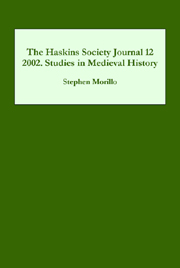Book contents
- Frontmatter
- Contents
- Editorial Note
- Abbreviations
- 1 Religious Houses and the Laity in Eleventh- to Thirteenth-Century England: An Overview
- 2 Two Yorkshire Historians Compared: Roger of Howden and William of Newburgh
- 3 The Rise and Fall of the Anglo-Saxon Law of the Highway
- 4 Consilium et Auxilium and the Lament for Æschere: A Lordship Formula in Beowulf
- 5 Royal Succession and the Growth of Political Stability in Ninth-Century Wessex
- 6 From Anglorum basileus to Norman Saint: The Transformation of Edward the Confessor
- 7 St þorlákr of Iceland: The Emergence of a Cult
- 8 Reshaping the Past on the Early Norman Frontier: The Vita Vigoris
- 9 The Appeal to Original Status in the Angevin Region (Eleventh–Twelfth Centuries)
- 10 Dudo of St. Quentin as an Historian of Military Organization
9 - The Appeal to Original Status in the Angevin Region (Eleventh–Twelfth Centuries)
Published online by Cambridge University Press: 12 September 2012
- Frontmatter
- Contents
- Editorial Note
- Abbreviations
- 1 Religious Houses and the Laity in Eleventh- to Thirteenth-Century England: An Overview
- 2 Two Yorkshire Historians Compared: Roger of Howden and William of Newburgh
- 3 The Rise and Fall of the Anglo-Saxon Law of the Highway
- 4 Consilium et Auxilium and the Lament for Æschere: A Lordship Formula in Beowulf
- 5 Royal Succession and the Growth of Political Stability in Ninth-Century Wessex
- 6 From Anglorum basileus to Norman Saint: The Transformation of Edward the Confessor
- 7 St þorlákr of Iceland: The Emergence of a Cult
- 8 Reshaping the Past on the Early Norman Frontier: The Vita Vigoris
- 9 The Appeal to Original Status in the Angevin Region (Eleventh–Twelfth Centuries)
- 10 Dudo of St. Quentin as an Historian of Military Organization
Summary
In the cartulary of the abbey of St. Serge – which is situated near Angers – there is this simple notice:
When Geoffrey, nicknamed Curtus, the son of Odo of Blaison, had become a knight, he wrongfully claimed the lock at Ecouflant, and the monks did not allow this situation to endure very long; the earnest requests of his brothers Johannes and Hugo, and of other friends of his, persuaded him to make a quitclaim. He did this in the chapter of St. Serge on 4 kalendas Januarii in the hands of abbot Bernard. The abbot and the monks then gave him 40s. and admitted him into the confraternity of the monks.
The fact that someone who had just become a knight claimed ownership of a piece of property which had once been donated by his father was not an uncommon phenomenon. In this case it was between 1056 and 1082 that half of the lock in the river Sarthe at Ecouflant had been given to the monastery of St. Serge by a man named Girvius de Saciaco; the donor had held the lock as a fief from Odo of Blaison, the father of Geoffrey Curtus. Later the monks of St. Serge had bought the second half of the lock from Odo of Blaison. In the case of the donation, Odo would have given his consent. In the sale he would have complied with a request of the monks to sell them the second half of the lock.
- Type
- Chapter
- Information
- The Haskins Society Journal 122002 - Studies in Medieval History, pp. 151 - 164Publisher: Boydell & BrewerPrint publication year: 2003

